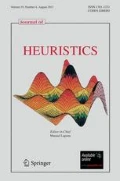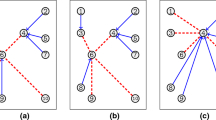Abstract
This paper addresses a variant of the many-to-many hub location-routing problem. Given an undirected edge-weighted complete graph \(G = (V, E)\), this problem consists in finding a subset of V designated as hub nodes, partitioning all the nodes of V into cycles such that each cycle has exactly one hub node, and determining a Hamiltonian cycle on the subgraph induced by hub nodes. The objective is to minimize the total cost resulting from all these cycles. This problem is referred to as Many-to-Many p-Location-Hamiltonian Cycle Problem (MMpLHP) in this paper. To solve this problem, one has to deal with aspects of subset selection, grouping, and permutation. The characteristics of MMpLHP change according to the values of its constituent parameters. Hence, this problem can be regarded as a general problem which encompasses a diverse set of problems originating from different combinations of values of its constituent parameters. Such a general problem can be tackled effectively by suitably selecting and combining several different heuristics each of which cater to a different characteristic of the problem. Keeping this in mind, we have developed a simple multi-start hyper-heuristic approach for MMpLHP. Further, we have investigated two different selection mechanisms within the proposed approach. Experimental results and their analysis clearly demonstrate the superiority of our approach over best approaches known so far for this problem.





Similar content being viewed by others
References
Applegate, D., Bixby, R., Chvatal, V., Cook, W.: The Traveling Salesman Problem: A Computational Study. Princeton University Press (2006)
Belenguer, J.M., Benavent, E., Prins, C., Prodhon, C., Calvo, R.W.: A branch-and-cut method for the capacitated location-routing problem. Comput. Oper. Res. 38(6), 931–941 (2011)
Braekers, K., Ramaekers, K., Nieuwenhuyse, I.: The vehicle routing problem: state of the art classification and review. Comput. Indus. Eng. 99, 300–313 (2016)
Bruns, A., Klose, A., Stähly, P.: Restructuring of swiss parcel delivery services. OR Spect. 22(2), 285–302 (2000)
Burke, E.K., Gendreau, M., Hyde, M., Kendall, G., Ochoa, G., Özcan, E., Qu, R.: Hyper-heuristics: a survey of the state of the art. J. Oper. Res. Soc. 64(12), 1695–1724 (2013)
de Camargo, R.S., de Miranda, G., Løkketangen, A.: A new formulation and an exact approach for the many-to-many hub location-routing problem. Appl. Math. Modell. 37(12), 7465–7480 (2013)
Çetiner, S., Sepil, C., Süral, H.: Hubbing and routing in postal delivery systems. Ann. Oper. Res. 181(1), 109–124 (2010)
Chakhlevitch, K., Cowling, P.: Hyperheuristics: recent developments. In: Adaptive and Multilevel Metaheuristics, pp. 3–29. Springer (2008)
Cowling, P., Kendall, G., Soubeiga, E.: A hyperheuristic approach to scheduling a sales summit. In: International Conference on the Practice and Theory of Automated Timetabling, pp. 176–190. Springer (2000)
Crowston, W.B., Glover, F., Trawick, J.D., et al.: Probabilistic and Parametric Learning Combinations of Local Job Shop Scheduling Rules. Technical report. Research Memorandum, No. 117, GSIA, Carnegie Mellon University, Pittsburgh (1963)
Denzinger, J., Fuchs, M., Fuchs, M.: High performance ATP systems by combining several AI methods. In: Proceedings of the 15th International Joint Conference on Artifical Intelligence, vol. 1, pp. 102–107. IJCAI’97, Morgan Kaufmann Publishers Inc., San Francisco, CA, USA (1997)
Drake, J.H., Özcan, E., Burke, E.K.: An improved choice function heuristic selection for cross domain heuristic search. In: International Conference on Parallel Problem Solving from Nature, pp. 307–316. Springer (2012)
Eksioglu, B., Vural, A., Reisman, A.: The vehicle routing problem: a taxonomic review. Comput. Indus. Eng. 57(4), 1472–1483 (2009)
Fisher, H.: Probabilistic learning combinations of local job-shop scheduling rules. Indus Sched. 225–251 (1963)
Garey, M.R., Johnson, D.S.: Computers and Intractability: A Guide to the Theory of NP-Completeness. W. H. Freeman, San Francisco (1979)
Gutin, G., Punnen, A.: The Traveling Salesman Problem and Its Variations, vol. 12. Springer Science & Business Media, Berlin (2006)
Kuby, M.J., Gray, R.G.: The hub network design problem with stopovers and feeders: the case of federal express. Transp. Res. Part A Policy Prac. 27(1), 1–12 (1993)
Labbé, M., Rodríguez-Martin, I., Salazar-Gonzalez, J.: A branch-and-cut algorithm for the plant-cycle location problem. J. Oper. Res. Soc. 55(5), 513–520 (2004)
Lloyd, S.P.: Least squares quantization in pcm. IEEE Trans. Inform. Theory 28(2), 129–137 (1982)
Lopes, M.C., de Queiroz, T.A., de Andrade, C.E., Miyazawa, F.: Solving a variant of the hub location-routing problem. In: LISS 2014, pp. 395–400. Springer (2015)
Lopes, M.C., de Andrade, C.E., de Queiroz, T.A., Resende, M.G., Miyazawa, F.K.: Heuristics for a hub location-routing problem. Networks 68(1), 54–90 (2016)
Nagy, G., Salhi, S.: The many-to-many location-routing problem. Top 6(2), 261–275 (1998)
Rodríguez-Martín, I., Salazar-González, J.J., Yaman, H.: A branch-and-cut algorithm for the hub location and routing problem. Comput. Oper. Res. 50, 161–174 (2014)
Wang, Z., Lin, C., Chan, C.K.: Demonstration of a single-fiber self-healing CWDM metro access ring network with unidirectional OADM. IEEE Photon. Technol. Lett. 18(1), 163–165 (2006)
Wilcoxon, F., Katti, S., Wilcox, R.A.: Critical values and probability levels for the wilcoxon rank sum test and the wilcoxon signed rank test. Select. Tables Math. Stat. 1, 171–259 (1970)
Acknowledgements
The authors would like to thank Dr. Carlos E. Andrade for providing the test instances of MMpLHP and responding to our queries pertaining to approaches of Lopes et al. (2016). The first author is grateful to the Council of Scientific & Industrial Research (CSIR), Government of India for supporting his research through a Senior Research Fellowship.
Author information
Authors and Affiliations
Corresponding author
Ethics declarations
Conflict of interest
The authors declare that they have no conflict of interest.
Ethical approval
This article does not contain any studies with human participants or animals performed by any of the authors.
Additional information
Publisher's Note
Springer Nature remains neutral with regard to jurisdictional claims in published maps and institutional affiliations.
Appendix A
Appendix A
Tables 9, 10, 11, 12, 13, 14, 15, 16, 17, 18, 19, 20, 21, 22, 23, 24, 25, 26, 27, 28, 29, 30, 31 and 32 of this appendix provide the instance-by-instance performance of HH_RAND and HH_GREEDY as well as the approaches of Lopes et al. (2016) on 24 different groups of instances. The detailed results of Exact, BRKGA, M-VND and LS approaches are taken from Lopes et al. (2016), where they reported only the best value among all the approaches (and not the individual best results for each approach). Further, %-deviation of Exact, BRKGA, M-VND and LS approaches from the best value is also reported. The results of M-CNS have been obtained from the corresponding author of Lopes et al. (2016) through personal communication, and these results were received in the same format as the reported results of other 4 approaches. From the best result and %-deviation information for each instance, we have calculated the cost for Exact, BRKGA, M-VND, M-CNS and LS approaches. Further, Lopes et al. (2016) did not report the execution times of Exact, BRKGA, M-VND, M-CNS and LS. Instead, time to reach the best solution is reported for each of these methods on each instance. Therefore, for Exact, BRKGA, M-VND, M-CNS and LS approaches, we can report the time till best only. We have decided to report the execution times of HH_RAND and HH_GREEDY as that is the standard practice in OR community and that will make future researchers working on this problem also to follow the standard practice. In Tables 9, 10, 11, 12, 13, 14, 15, 16, 17, 18, 19, 20, 21, 22, 23, 24, 25, 26, 27, 28, 29, 30, 31 and 32, the first column lists the instance name where the digits at the end represent the number of nodes in that instance. For each approach, the column ‘cost’ reports the objective value obtained by that approach. The column ‘btime’ for Exact, BRKGA, M-VND, M-CNS and LS approaches reports the time in seconds to find best solution for that approach. The column ‘etime’ for HH_RAND and HH_GREEDY reports the execution time in seconds for that approach. All the times are actual times on respective machines without any multiplication factor to account for difference in processing speeds. Please also note that there is a time limit of 3600 s for all the approaches, however this condition is checked only once during an iteration, and hence, reported time can exceed 3600 s in some cases.
Rights and permissions
About this article
Cite this article
Pandiri, V., Singh, A. A simple hyper-heuristic approach for a variant of many-to-many hub location-routing problem. J Heuristics 27, 791–868 (2021). https://doi.org/10.1007/s10732-021-09477-x
Received:
Revised:
Accepted:
Published:
Issue Date:
DOI: https://doi.org/10.1007/s10732-021-09477-x




